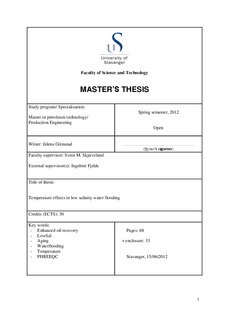| dc.contributor.author | Grimstad, Jelena | |
| dc.date.accessioned | 2012-11-09T09:34:55Z | |
| dc.date.available | 2012-11-09T09:34:55Z | |
| dc.date.issued | 2012 | |
| dc.identifier.uri | http://hdl.handle.net/11250/183478 | |
| dc.description | Master's thesis in Petroleum engineering | no_NO |
| dc.description.abstract | In the past years it has been observed that low salinity floods often lead to production of additional oil recovery. Several theories have been proposed as explanation for improved oil recovery, though the key mechanism is still under discussion.
Different effects of temperature in conducted experiments with low salinity injections have been reported. Generally, additional oil recovery with increased temperature is explained by changing oil properties and wettability modifications. An experiment in 2009 by Cissokho, H.Bertin et al. showed that incremental oil recovery was highest at moderate temperatures rather than high.
In this study, temperature effects on low salinity flooding were investigated by a simulation based on experimental results. Simulations included two mechanisms: equilibrium of phases and ion exchange. A PHREEQC model was used to analyze the temperature effects on interaction of low salinity water with a reservoir rock from a North Sea.
Observed results showed that:
The total amount of divalent ions in low salinity brine is affected by changes in temperature though the dependency is not straight forward/ linear and is affected by ionic strength of brine, composition and composition of reservoir rock. Therefore each case should be treated separately.
Aging of rock, brine and oil and LSWF have to be conducted at the same temperatures to avoid possible precipitation/dissolution of minerals as a result of change in temperature.
The first aging between the brine, rock and oil happens at reservoir temperature. It is important to establish equilibrium between rock, brine and oil at new temperature before the flooding experiment at the same temperature is carried out. New aging establishes more representative wettability conditions allowing estimation of relative permeability and oil saturation that gives a good match between the simulation and experimental data.
The simulation results have to be compared with experimentally measured changes in ionic concentrations in brines as well as precipitated minerals to be able to tune the rates together with saturation indexes. | no_NO |
| dc.language.iso | eng | no_NO |
| dc.publisher | University of Stavanger, Norway | no_NO |
| dc.relation.ispartofseries | Masteroppgave/UIS-TN-IPT/2012; | |
| dc.subject | petroleumsteknologi | no_NO |
| dc.subject | low salinity | no_NO |
| dc.subject | produksjonsteknologi | no_NO |
| dc.subject | enhanced oil recovery | no_NO |
| dc.subject | EOR | no_NO |
| dc.subject | waterflooding | no_NO |
| dc.title | Temperature effects in low salinity waterflooding | no_NO |
| dc.type | Master thesis | no_NO |
| dc.subject.nsi | VDP::Technology: 500::Rock and petroleum disciplines: 510::Petroleum engineering: 512 | no_NO |
| dc.source.pagenumber | 101 | no_NO |
